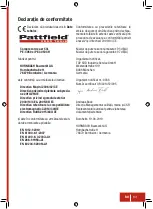
EN
145
will reduce the risk of shock, fire, or seri-
ous injury.
26.
Make sure your extension cord is in
good condition.
When using an extension
cord, be sure to use one heavy enough to
carry the current your product will draw. A
wire gauge size at least 1 mm
2
is recom-
mended for an extension cord 7.6 m or less
in length. A cord exceeding 15 m is not rec-
ommended. If in doubt, use the next heav-
ier gauge. The smaller the gauge number,
the heavier the cord. An undersized cord
will cause a drop in line voltage, resulting
in loss of power and overheating.
27.
Do not use tool inside a garage.
Follow-
ing this rule will reduce the risk of igniting
fuel vapours.
28.
Never store tool with air connected.
Storing a tool with air connected can result
in unexpected firing and possible serious
personal injury.
29.
Protect your lungs.
Wear a face or dust
mask if the operation is dusty. Following
this rule will reduce the risk of serious per-
sonal injury.
30.
Do not operate compressed-air hoses
above the rated pressure.
Following this
rule will reduce the risk of serious personal
injury.
31.
If the power supply cord is damaged, it
must be replaced only by the manufac-
turer or by an authorized service center
to avoid the risk of electric shock or
product malfunction..
32.
Save these instructions.
Refer to them
frequently and use them to instruct others
who may use this tool. If you loan someone
this tool, loan them these instructions also.
33.
When the machine is in operation,
many parts of the machine may cause
a high temperature.
Use necessary per-
sonal protection equipment such as gloves
to avoid injuries resulting from a high tem-
perature.
34. Avoid heavy loads on the pipe system by
using flexible hose connections to avoid
kinks.
35. Regularly check oil level and top up oil, if
necessary. Perform complete oil change
regularly. Only use oil compliant to section
“Technical Data”. Keep cooling ribs clean.
36. Do not exceed the maximum inclination
given in section “Technical Data”.
MACHINE SPECIFIC SAFETY WARNINGS
FOR SPRAY GUNS
a)
Only spray coating materials (paints,
varnishes, glazes, etc.) with a flashpoint
of 55 °C and higher without additional
warning
. Hazard classes A II and A III (Ger-
man classification of coating material, see
material tin).
b)
Make sure the spray gun is not used in
workplaces covered by the explosion-
protection regulations.
c)
Keep away from sources of ignition like
open fires, lit cigarettes, cigars or pipes,
sparks, glowing wires and hot surfaces
when spraying.
d)
Do not spray materials whose hazard
potential is not known.
e)
Do not store or consume food or bever-
age in the workshop.
Paint vapours are
harmful to health.
f)
Do not use the spray gun to spray flam-
mable materials.
g)
Do not clean the gun with flammable
solvents (flashpoint under 55 °C).
h)
Beware of hazards that can arise from
the sprayed materials.
Observe the infor-
mation and specifications provided with the
materials.
i)
Wear a breathing mask and eye protec-
tion when spraying.
j)
Never point the spray gun at yourself, at
other people or at animals.
k)
Make sure that no solvent vapours are
sucked in by the spray gun.
l)
Ensure adequate ventilation when
working indoors.
m)
Pay attention to the wind when working
outdoors, it can carry the coating mate-
rial across greater distances and cause
damage.
n)
Only use in workshops larger than
30 m
3
with sufficient ventilation during
spraying and drying.
Summary of Contents for PE-3050
Page 18: ...DE 18...
Page 36: ...FR 36...
Page 54: ...IT 54...
Page 104: ...CZ 104...
Page 122: ...SK 122...
Page 140: ...RO 140...











































